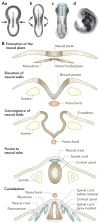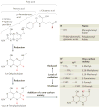Neural tube defects and folate: case far from closed
- PMID: 16924261
- PMCID: PMC2970514
- DOI: 10.1038/nrn1986
Neural tube defects and folate: case far from closed
Abstract
Neural tube closure takes place during early embryogenesis and requires interactions between genetic and environmental factors. Failure of neural tube closure is a common congenital malformation that results in morbidity and mortality. A major clinical achievement has been the use of periconceptional folic acid supplements, which prevents approximately 50-75% of cases of neural tube defects. However, the mechanism underlying the beneficial effects of folic acid is far from clear. Biochemical, genetic and epidemiological observations have led to the development of the methylation hypothesis, which suggests that folic acid prevents neural tube defects by stimulating cellular methylation reactions. Exploring the methylation hypothesis could direct us towards additional strategies to prevent neural tube defects.
Conflict of interest statement
The authors declare no competing financial interests.
Figures





References
-
- Elwood JM, Little J, Elwood JH. Epidemiology and Control of Neural Tube Defects. Oxford Univ. Press; 1992.
-
- Waitzman NJ, Romano PS, Scheffler RM. Estimates of the economic costs of birth defects. Inquiry. 1994;31:188–205. - PubMed
-
- Copp AJ, Greene NDE, Murdoch JN. The genetic basis of mammalian neurulation. Nature Rev Genet. 2003;4:784–793. Excellent review of mammalian neurulation. - PubMed
Publication types
MeSH terms
Substances
Grants and funding
LinkOut - more resources
Full Text Sources
Medical

